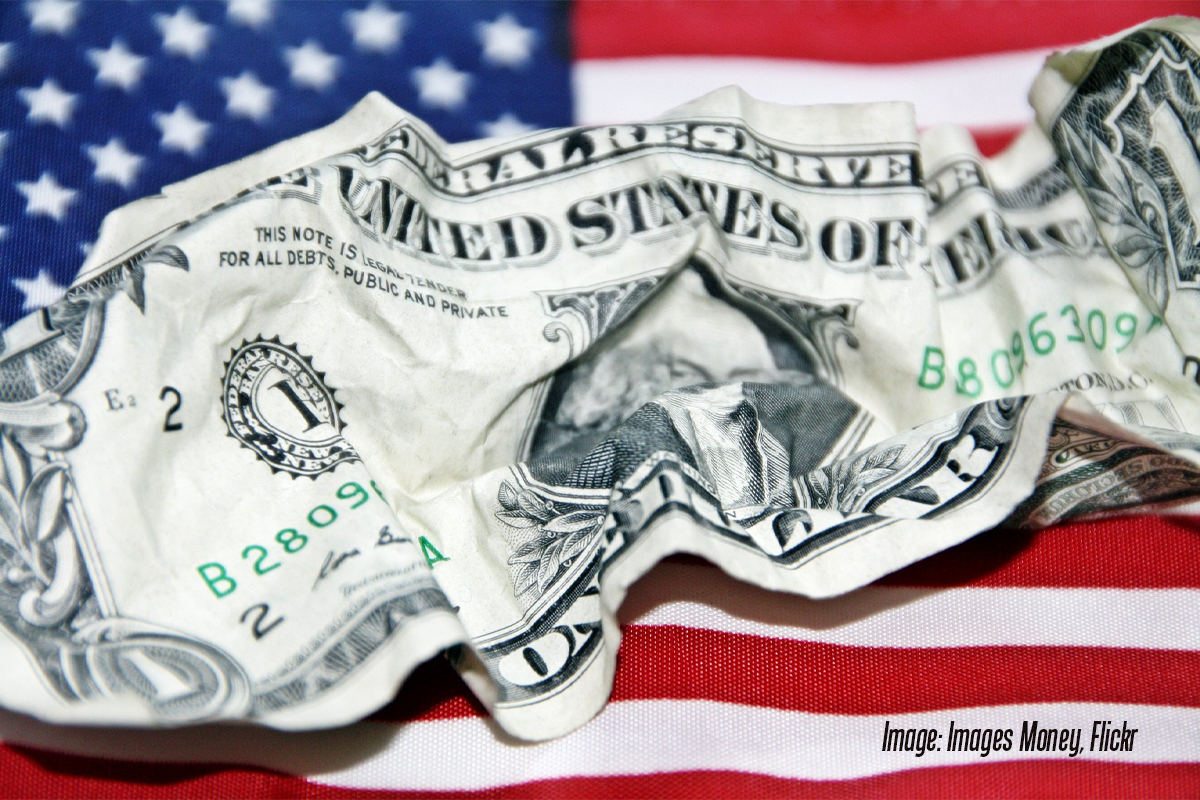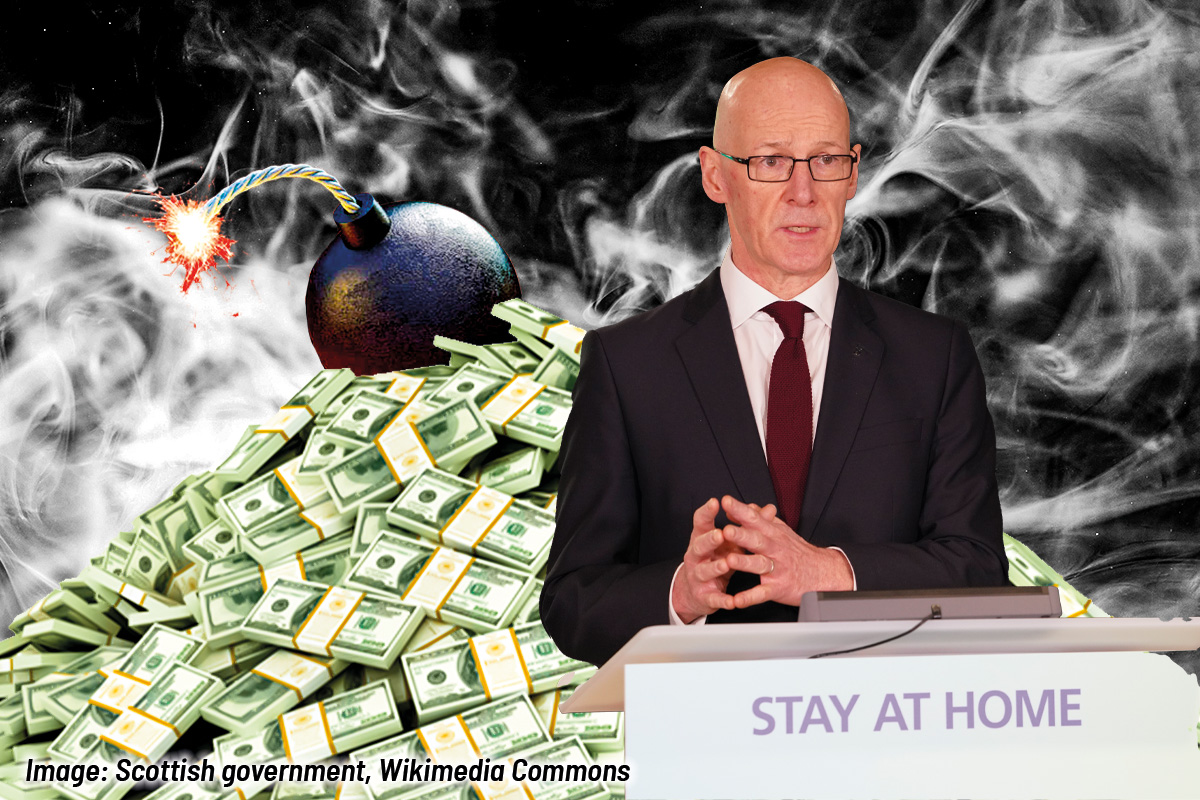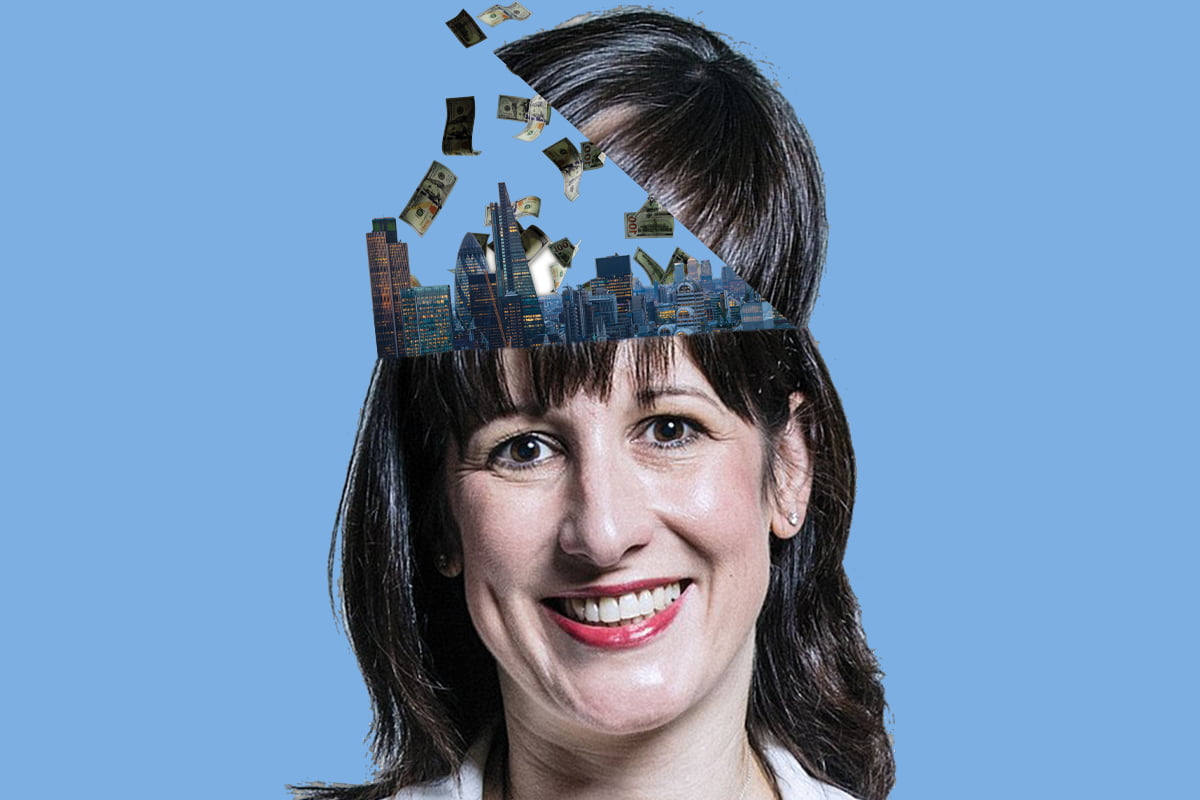From Wall Street, to the White House, to the West Coast: the USA is currently a picture of chaos and crisis – economically, politically, and socially.
In recent weeks, protests have raged in Los Angeles, with workers and youth confronting armed immigration agents, police officers, and National Guard troops.
Washington, meanwhile, has been gripped by in-fighting lately: within the administration regarding what strategy to pursue in the Middle East; and prior to that, in Congress over Donald Trump’s ‘big beautiful bill’.
Trump’s fiercely-debated legislation threatens to drive up the US government’s budget deficit and national debt. According to the congressional fiscal watchdog, the President’s tax bill will add $2.4 trillion to America’s already-massive debt mountain by 2034.
This has provoked a public split between Trump and his chainsaw-wielding billionaire sidekick, Elon Musk. The libertarian Tesla boss has attacked the bill as a “disgusting abomination”, arguing that it would undo the efforts of his ‘DOGE’ – the Department of Government Efficiency – to slash federal expenditure.
I’m sorry, but I just can’t stand it anymore.
This massive, outrageous, pork-filled Congressional spending bill is a disgusting abomination.
Shame on those who voted for it: you know you did wrong. You know it.
— Elon Musk (@elonmusk) June 3, 2025
But it is not just Musk who has shown hostility towards the administration’s tax-and-spend plans. The Republican Party is divided over Trump’s proposals. And investors are also panicked by his economic programme.
The US President promises to ‘Make America Great Again’. On the whole, however, the capitalists do not trust that this will be the outcome of Trump’s agenda.
In the short-term, America’s CEOs and creditors alike are deeply alarmed by the uncertainty and instability that the President’s policies are creating: firstly with his capricious approach to tariffs and trade; and now on the question of the budget. After all, this is hardly a healthy environment for profit-making.
In the long-term, meanwhile, the serious strategists of US imperialism are worried about the damage that Trump is doing to America’s position globally: undermining confidence in US capitalism, including its assets and its currency, and thereby accelerating the country’s relative economic decline.
The rest of the world is also following this pandemonium closely. After all, as the saying goes, when America sneezes, the rest of the world catches a cold. And US capitalism has more than a little sniffle these days.
End of an era
Since returning to the White House, Donald J. Trump has certainly set the proverbial cat amongst the pigeons, at home and abroad.
Within the first 100 days of his second term, the American President managed to take a sledgehammer to every pillar of the liberal world order. And he has continued to chip away at these since.
The so-called ‘rules-based’ diplomacy of international relations has been upended.
Trump has threatened to annex Canada, Greenland, and Panama. He has sidelined longstanding US allies in Europe, in favour of rapprochement with ‘pariah’ states like Russia. And he has put USAID – part of American imperialism’s ‘soft power’ toolbox – “into the woodchipper”.
Similarly, leading figures in Trump’s administration have disparaged the transatlantic relationship between the US and Europe. This has led to uncertainty about the future of the NATO military alliance – another cornerstone of the postwar status quo.
With his ‘Liberation Day’ blitzkrieg of tariffs in early April, meanwhile, the US President ramped up America’s trade war against both its ‘friends’ and its foes.
Nobody, including Trump, knows exactly where this will end up. But everyone can see that a chapter has been turned.
The era of free trade and globalisation is over. Protectionism and economic nationalism is now the overriding trend. Another bastion of the liberal order – one that was already fracturing – has been dealt a heavy blow.
Now, by pushing American debt up to even more eye-watering and unsustainable levels, Trump is further undermining trust in US treasuries (federal government bonds) as a ‘safe haven’ for global capital.
Furthermore, also contained within his ‘big beautiful bill’ are a set of clauses (Section 899) that would empower the US government to impose a ‘revenge tax’ on foreign investors. This amounts to a form of capital control, which is likely to scare financiers and wealth managers in other countries away from American assets.
Combined with the unpredictability of Trump’s ever-changing trade policy, this is all leading to greater questioning about the stability, security, and strength of US capitalism; and, in turn, about whether the dollar can continue to play its current role as the world’s leading currency.
This, in turn, represents the erosion of yet another pillar of the postwar order: the dollar-based international financial system. And the crumbling of this key capitalist column could perhaps have the most explosive consequences of them all.
Bretton Woods
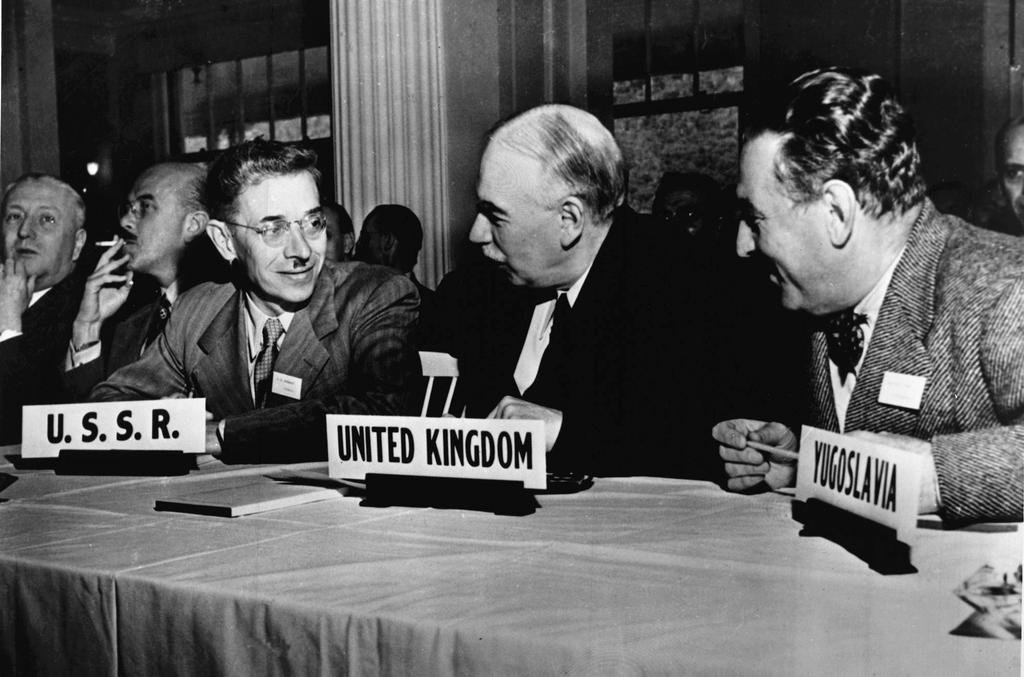
Each of these pillars of the postwar order came into being with a corresponding institution or arrangement.
The United Nations was the supposed arbiter of ‘international law’ and ‘rules-based’ diplomatic relations. NATO (the North Atlantic Treaty Organisation) was the West’s security umbrella. And GATT (the 1947 General Agreement on Tariffs and Trade), followed by the WTO (World Trade Organisation), was designed to promote the liberal ideal of free trade.
In 1944, meanwhile, delegates at the Bretton Woods conference agreed to US proposals for a new international monetary and financial system, centred around the dollar.
This included the establishment of the International Monetary Fund (IMF) and the International Bank for Reconstruction and Development, the precursor to today’s World Bank.
And, importantly, it saw the creation of the Bretton Woods monetary arrangement, as a replacement for the old gold standard. From then on, the American ‘greenback’ would be the de facto world currency, lubricating global finance and trade.
This was made possible by the dominance of US capitalism. At the time of the Bretton Woods negotiations, the American economy accounted for around 35 percent of the world’s GDP. And there was universal demand for dollars – particularly in Europe – to fund reconstruction.
Uncle Sam was sucking in money from the rest of the world. US monopolies were exporting hand over fist, leading to massive trade surpluses. Consequently, two-thirds of the world’s bullion sat in the vaults of Fort Knox. The dollar was thereby deemed ‘as good as gold’.
The Bretton Woods system, in other words, was effectively a dollar-based gold standard, under the aegis of US imperialism.
Hegemonic position
The same is true for the rest of this web of western imperialism, which had Washington and New York at its epicentre in every respect.
The UN, NATO, WTO, and IMF: all of these were – and remain today – tools of US imperialism, designed to advance the interests of America’s bosses and bankers.
Nevertheless, emerging from the ashes of the Second World War, other second and third-rate powers saw a benefit to huddling behind this undisputed hegemon of the capitalist world.
Although American banks and monopolies were by far-and-away the biggest beneficiaries of free trade and a dollarised financial system, other western ruling classes were happy to piggyback on this new global setup, which seemingly bestowed peace and prosperity upon the whole of society.
The existence of an uncontested imperialist power – a recognised world policeman and custodian of global capitalism – provided the economic and political stability upon which business could be conducted and juicy profits made.
US imperialism’s unrivalled position coming out of the war, in this respect, was an important factor behind the massive, unprecedented upswing seen in the decades after WW2.
The removal of tariffs and protectionist barriers, under America’s insistence, allowed for a huge growth in international trade. This, in turn, gave a tremendous boost to the integration of the world economy and the division of labour globally, and thereby to greater economies of scale and productivity.
The US Marshall Plan, meanwhile, helped to avert revolution in Europe, thereby saving the capitalists and their system from overthrow by a highly-radicalised working class.
The deal was unofficial, but implicit. The ruling classes in other advanced economies could freeride on US military spending, and gorge on the fruit of free trade. All they had to do in return was prostrate themselves before their new American masters.
Objective needs
At the level of individual capitalists and nations, this subservience to US imperialism was clearly motivated by naked, narrow self-interest.
Nevertheless, it is evident that the capitalist system – as an interconnected, worldwide whole – has an objective need for a single monetary and financial framework within which economic activity can operate.
Every capitalist may be looking out for their own interests, in competition with each other. But they still collectively benefit from having an agreed set of standards; a common architecture for finance and trade.
Historically, money developed for similar reasons. With the rise of commodity production and exchange in early class societies comes the emergence of a money commodity: a single good that can be traded for all others, thereby acting as a universal equivalent and measure of value.
Traditionally, it is precious metals like silver and gold that have played this role, helping to lubricate trade and commerce; circulation and exchange.
Marx, in this respect, explained that money serves several essential functions within a commodity-based economy. Regardless of its various forms over the centuries and millennia, everywhere and always it is both a means of exchange and a store of value.
In turn, with the development of an integrated world economy comes the need for an international monetary system and a recognised global currency, in order to facilitate finance and trade.
International trade is easier for everyone if there is a common currency for transactions and contracts. Global investors, meanwhile, have a desire for a universally-accepted, liquid asset where they can park their money for safekeeping.
Bourgeois economists refer to this phenomenon as the dynamics of ‘network effects’: the order that arises dialectically in a chaotic system of seemingly random, accidental interactions; the tendency for people, businesses, and entire nations to gravitate towards the same tools and structures out of mutual ease and benefit.
Communication between friends, for example, is smoother and simpler if everyone is on the same messaging app. This leads to a concentration of users on certain tech-monopoly-owned platforms.
Similarly when it comes the emergence of socio-economic means for the exchange and circulation of commodities: whether it be the universal equivalent of a money commodity in earlier forms of class society; or an effective world currency in modern times.
Gold standard
In the 19th and early-20th century, during the heyday of the British Empire, global finance and trade was conducted within the framework of the gold standard.
At that time, British imperialism was the world’s hegemon, playing a similar role to that of US imperialism in the postwar period – providing the stable economic and political foundations upon which world trade and industry could flourish.
It was British thinkers like Adam Smith and David Ricardo, in turn, who developed the ideas of bourgeois ‘political economy’, championing liberalism, free trade, and the ‘invisible hand’ of the capitalist market.

By the end of the 19th century, however, it was clear that British capitalism was being overtaken by its rivals.
The First World War catalysed the changing balance of forces between the powers. Britain, France, and Germany all emerged heavily weakened from this catastrophic conflict. US capitalism, by comparison, was clearly a dynamic force.
The Treaty of Versailles left Germany heavily indebted to Britain and France, who in turn owed huge sums to the USA. Meanwhile, the war accelerated the migration of global financial activity from the City of London to Wall Street.
Britain was no longer in a position to be the global guardian of world trade and finance. At the same time, US imperialism was not yet strong enough to assume this mantle.
This contributed towards the turbulence of the interbellum years, amplifying all the accumulating contradictions in the capitalist system.
The old gold standard finally collapsed – after years of tensions and tumult – during the Great Depression.
With the world economy in the doldrums, country after country abandoned the shackles of a metallic monetary base, in order to print money, competitively devalue their own national currencies, and export their crises elsewhere.
At the same time, capitalist politicians turned to protectionist ‘beggar-thy-neighbour’ policies, including large tariff barriers to deter imports. But this only worsened the slump.
New equilibrium
It was only through the devastating destruction of the Second World War that a new capitalist equilibrium emerged. And it was US imperialism that was the global gendarme of this postwar order.
As capitalism’s new international hegemon, Uncle Sam provided the ‘public goods’ upon which the rest of the western ruling classes relied: guaranteeing military protection for its allies; maintaining open markets; ensuring a stable currency; and acting as the world economy’s lender of last resort.
This was all sanctified in the aforementioned institutions and arrangements – including the Bretton Woods agreement in regards to monetary matters.
In the years and decades following the war, however, whilst the global economy was booming as a whole, US capitalism underwent a relative decline.
America’s rivals became more economically competitive. US monopolies started losing their market share to German and Japanese industry. As a result, by the early 1970s, US fiscal and trade surpluses had turned into deficits.
At the same time, through the postwar period, successive White House administrations helped to undermine the integrity of the dollar.
In an effort to curb the atrophy of US capitalism, the American ruling class was recklessly printing money to fund wars, purchase foreign assets, and indulge in speculative ventures. The result was a built up inflationary pressures in the US and world economy.
With a mass of dollars sloshing around, and relatively few US metallic reserves to underpin these, doubts were increasingly raised about the convertibility of the dollar into gold – the backbone of Bretton Woods. This led to runs on the American currency, which was clearly overvalued.
On 15 August 1971, US President Nixon unilaterally suspended any exchange of greenbacks for gold. Bretton Woods was soon abandoned in favour of floating currencies and competitive devaluations.
This was a harbinger of the global crisis of 1973-75; one of a series of shocks that marked the end of the prolonged boom, and a turning point in capitalism’s development.
The death knell of the postwar economic order had been struck.
Exorbitant privilege

Paradoxically, however, the end of the Bretton Woods arrangement, and the move to a setup of floating fiat currencies, saw the dollar become even more central to the international financial system.
The dollar was no longer the official global currency. But for the reasons outlined above, there remained an objective need for something to play this role.
In particular, as the world economy grew and became ever-more integrated in the following decades, capitalism globally had an even greater requirement for a dominant currency through which to conduct trade, and for a safe haven where investors could store their wealth.
And in the absence of any clear alternative, the dollar and US treasuries continued to serve these functions, respectively.
This has largely served the rest of the world’s capitalists well. Nevertheless, the dollar’s international status also confers on US capitalism (what bourgeois economists refer to as) an ‘exorbitant privilege’.
High demand for dollar-denominated assets – including US stocks and bonds – means that American banks and businesses can generally borrow at lower interest rates, which translates into higher profits.
Similarly, with global investors craving American securities, the US federal government has far more freedom than others in regards to public borrowing and running deficits. There is seemingly unlimited appetite when it comes to buying up US debt.
Furthermore, US central bankers have more autonomy when it comes to setting monetary policy. Yet the decisions that they make can send shockwaves across the planet. In recent years, for example, the Fed’s move to raise interest rates and ‘taper’ quantitative easing has caused jitters and spasms in the rest of the world economy.
Finally, the fact that the entire international financial system is built around the dollar provides US imperialism with a powerful economic weapon: the ability to seize foreign assets; impose sanctions on its enemies; freeze them out of the world economy; and thereby inflict widespread harm.
On every front, however, the US ruling class has abused these privileges.
The American capitalists have rested on their laurels and become addicted to cheap credit. Consequently, US monopolies are increasingly being overtaken by their international rivals, particularly those from China.
Successive governments, meanwhile, have allowed America’s debt pile and borrowing costs to reach crushing levels. Every new crisis has been met with bailouts and blank cheques for the banks and big business. And even in so-called ‘normal’ times, deficit financing and easy money has been used to provide a semi-permanent economic sugar rush.
The US ruling class’ myopic approach, however, has caused collateral damage across the global economy. A deluge of fictitious capital now expresses itself in stubbornly-high inflation everywhere. The whole system is riddled with combustible contradictions; wracked with instability.
Last but not least, US imperialism has been hoist by its own petard when it comes to Washington’s weaponisation of the dollar.
Russia and China are increasingly circumventing US sanctions and restrictions. Other countries are diversifying when it comes to their currency reserves. And foreign investors are moving their money into assets beyond America’s reach, lest they suddenly find themselves on the wrong side of the occupants of the Oval Office.
In short, years of hubris and arrogance are beginning to catch up with US capitalism and its representatives. All the chickens are coming home to roost.
Game of chicken
This process has been ongoing for some time. But Trump’s policies are bringing things to a head, leading to rapidly growing concerns about US capitalism and its currency.
Ever since ‘Liberation Day’, stock markets have been on a rollercoaster ride. Big money managers like pension funds are dropping their holdings of US assets, and looking to instead buy up European bonds and shares. And the value of the dollar has been on a downward trajectory for months – down 10 percent since January, and now at a three-year low.
By contrast, in the four years from early 2021 to the start of 2025, the value of the dollar soared.
On the one hand, this was the result of speculative bets on US stocks, particularly Big Tech. On the other hand, it was a product of the world’s wealth holders pouring their money into US treasuries, seeking a refuge amidst all the instability and uncertainty afflicting capitalism globally.
Notably, the recent decline in the dollar is counter to what would be expected as a result of Trump’s tariffs and barriers to imports.
The aim of such protectionism is precisely to reduce America’s trade deficit. All else being equal, this should strengthen the US currency, by boosting the global net-demand for dollars, as the balance of trade between the rest of the world and the United States tips more in the latter’s favour.
The fact that the greenback’s value is plummeting is therefore an indication that investors are now abandoning US assets, reducing demand for dollars.
Currently, by value, American stocks account for around 60 percent of the global equity market. Meanwhile, foreigners own $62 trillion-worth of US assets – including one third of US government debt, amounting to $9 trillion. Overall, the size of the treasury bond market stands at $29 trillion, up from roughly $5 trillion in 2008.
Now, however, in light of recent events, international investors are starting to reassess their financial strategies. Through the erratic movements of the market, the capitalists are forcefully making their opinions known about Trump’s programme.
Shares in American big business are starting to seem overpriced, given the entrance of new competitors in fields like AI, airlines, and automobiles. On top of Trump’s trade war, Section 899 – which threatens an additional ‘retaliatory’ tax on foreign investors – has made foreign investors anxious. And with US debt set to balloon, treasuries no longer appear to be a sanctuary for global capital.
“The US has been the best place in the world to invest for a century,” remarked Howard Marks, co-founder of asset managers Oaktree Capital, speaking to the Financial Times. “But I’m starting to hear investors question whether US exceptionalism is a little less exceptional, and think about whether to position their portfolios accordingly.”
“I think it is untenable for the United States to continue borrowing at the pace it’s borrowing,” stated Seth Bernstein, CEO of global investment firm AllianceBernstein, in the same FT article.
“When you couple that with what’s going on with the unpredictability of our trade policy,” Bernstein continued, “it should cause people to pause and consider: how much do you want concentrated in one market?”
Last month, meanwhile, credit rating agency Moody’s followed in the footsteps of S&P and Fitch by stripping the US of its top-notch triple-A sovereign rating.
This admonishment came in response to estimates that Trump’s ‘big beautiful bill’ could push the ratio of American federal debt-to-GDP up by 25 percentage points to a record 125 percent by the end of 2034.
“This decision was a long time in coming,” commented Ann Rutledge, a former senior analyst at Moody’s, “and it’s a dire warning.”
The result has been a further rise in US borrowing costs. This has been reflected in terms of soaring yields on America’s 30-year government debt, which are now over 5 percent, as the price of US treasuries falls due to declining demand from investors.
In short, Trump is playing a game of chicken with the markets. And it is likely that the US President will be the one to blink first.
In fact, Trump has already stepped back from the brink a number of times: threatening to impose crippling tariffs, only to press pause when the backlash from the bond markets and big business becomes apparent.
After all, under capitalism, it is the dictatorship of bankers and billionaires who ultimately get to decide.
Market correction
The President’s chaotic approach – announcing and then withdrawing tariffs, for example – comes at a cost, however. Every instance of bluster followed by backtracking only further undermines investors’ confidence in American capitalism.
This is pushing the bankers and bosses to seek safer shores for their money; countries with more certain climates for profit-making. And instead of making America great and bringing back industrial jobs, it is accelerating US capitalism’s decline.
Trump’s economic policies may have been the trigger for this market avalanche. In truth, however, the conditions for this precarious landslide have been building for some time.
At a more fundamental level, investors’ recent moves away from the US dollar, bonds, and stocks represent an overdue realignment; a ‘market correction’, bringing the price of America’s currency and assets in line with reality.
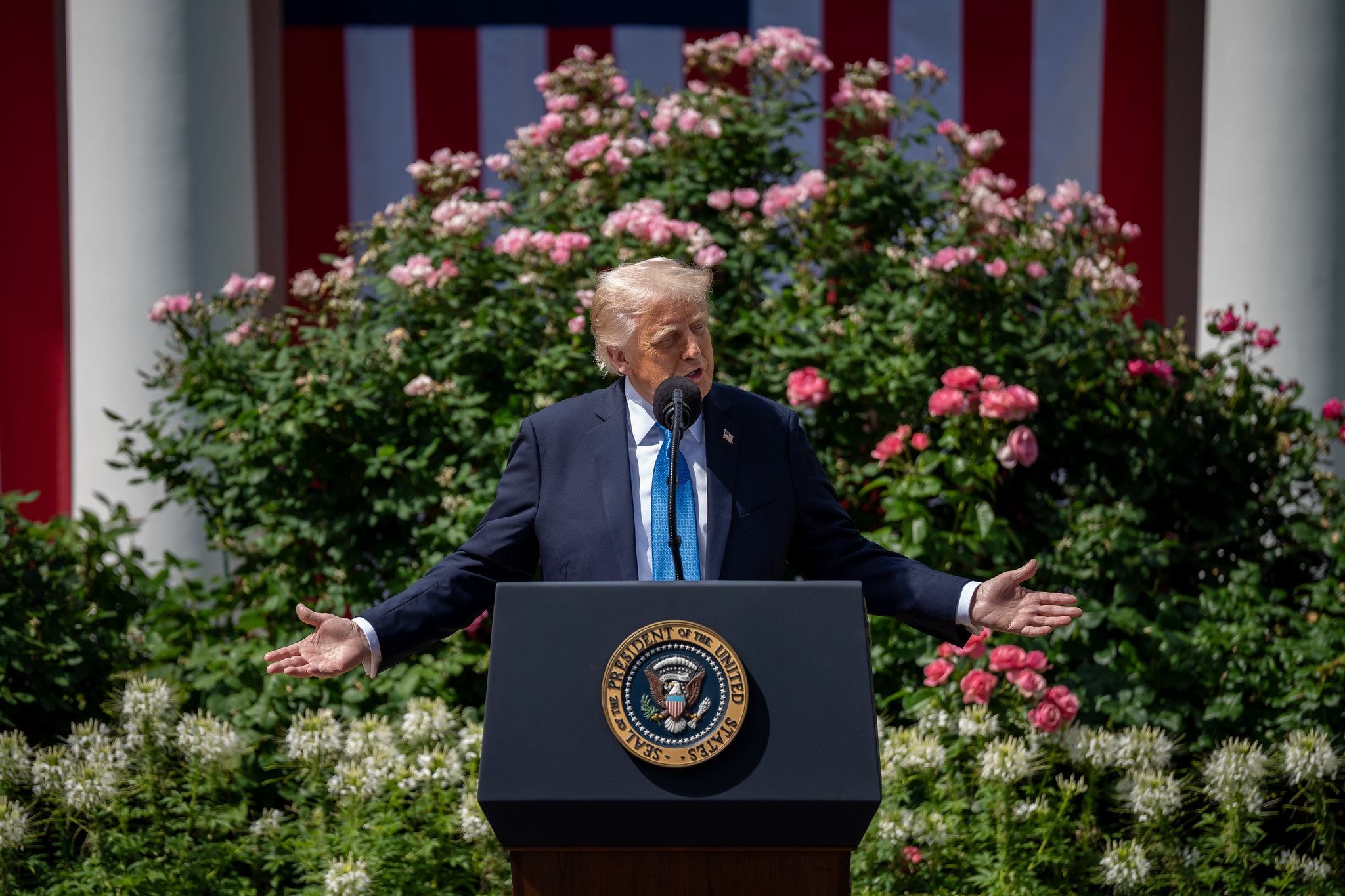
The fact is that US capitalism, whilst still the world’s biggest economy, is no longer the competitive, profitable powerhouse that it once was.
As previously mentioned, at the time of the Bretton Woods conference, the US represented 35 percent of the world’s GDP. In 1985, after some ebb and flow, America’s share of global output was back at this same level. Now, however, this figure is down to 26 percent.
In the same period, meanwhile, over the past forty years, China has grown from 2.5 percent of worldwide GDP to almost 17 percent.
Similarly, Chinese monopolies like DeepSeek and BYD are now challenging American firms in forefront industries like advanced tech and electric vehicles, biting into the profits and markets of US big business.
At the same time, decades of irresponsible, short-sighted policies by the US ruling class – including money printing, state intervention, and financial deregulation – have eroded confidence in the American government’s credit-worthiness; its ability to pay back its titanic debts.
Some are now pondering whether Trump might even renege on America’s obligations, rather than make the politically painful choice of which parts of the federal budget to axe.
This could come in the form of an open default on US government debt. Or the same outcome could be achieved by equivalent means: mass printing dollars, leading to debasement of the currency and a devaluation of America’s debt burden; or unilaterally imposing new terms on existing US treasury holders.
If Trump were to recklessly pursue one of these paths, he would risk provoking a global financial armageddon.
Havoc would grip the markets, as investors fled from hazardous or worthless US assets, in search of dry ground. The balance sheets of all the big banks and giant asset managers would be sent into disarray. A credit crunch would undoubtedly ensure, as lenders called in loans left, right, and centre.
The world would be gripped by a new financial crisis, even larger than that of 2007/08. And, in turn, the global economy would be plunged into a deep slump, or even a depression.
As with tariffs, when it comes to the literal $36 trillion question of US debt, Trump may well back down in the face of a potential market reckoning – just as former UK Prime Minister Liz Truss was forced to do, when faced with a similarly explosive scenario in September 2022.
But to avoid such a judgment day, the US President would instead be forced to confront the mighty American working class. To guarantee the bankers their pound of flesh, Trump would have to carry out brutal austerity and attacks on jobs, living standards, and social security.
In other words, to restore the economic equilibrium, the US ruling class would have to wage a class war on workers and the poor, leading to social explosions and enormous political instability.
No alternatives
In all likelihood, the US ruling class will attempt to do what they have done – repeatedly and empirically – from 2008 onwards: kick the can down the road; utilise the support of the state and the central bank in response to any shock or crisis; and avoid any hard decisions or denouement by raising the debt ceiling.
There is a limit to all things, however. And the mercurial Trump is not a reliable representative of the ruling class.
The serious strategists of capital are therefore genuinely worried about the possibility of the President catalysing all the accumulated contradictions in the system with his rash behaviour, and thereby unexpectedly or accidently precipitating a financial meltdown.
This explains the apocalyptic visions that are preying on the minds of the bourgeoisie, with alarming headlines in papers like the Financial Times, forewarning that “the spectre of dollar doomsday still looms”.
At the same time, what options do the ruling class have?
The problem can be formulated very simply. On the one hand, there is an objective economic need for a world currency and financial safe haven. On the other hand, there is no viable alternative to the US dollar and treasuries, respectively, when it comes to fulfilling this role.
US capitalism may have undergone a relative decline. But the greenback retains an outsized importance within the global financial system; a disproportionate weight compared to America’s share of the world economy.
A massive 58 percent of global currency reserves are held in US dollars, for example. This figure is down from 73 percent in 2001. But it is still far ahead of the euro’s 20 percent, or the Chinese yuan’s 2 percent.
An ‘index of international currency usage’ compiled by economists at the Federal Reserve, comparing the global adoption of major currencies, puts the US dollar at 60.7 – over twice the level of the euro, at 29.7.
The dollar is also the basis for 88 percent of foreign exchange transactions; 81 percent of trade finance, through the SWIFT international payments system; 54 percent of the world’s exports invoicing; 48 percent of global bonds; and 47 percent of cross-border banking claims.
In many cases, businesses will trade in dollars, even when neither side is based in the USA – a reflection of the ‘network effects’ described earlier. The result is that an estimated 45 percent of greenbacks are actually held overseas, outside of America.
Having established itself as the keystone of global trade and finance, it will be very difficult for any other currency to displace the dollar on the world stage.
To play this part requires certain prerequisites. A reserve currency or safekeeping asset needs to be reliable and liquid: stable in price; easily exchangeable; and abundant enough to satisfy the thirst of private investors and public bodies (including sovereign states) for somewhere to store their wealth.
In addition, such a device needs to be deemed trustworthy by society’s wealthkeepers. A global currency, in other words, must be backed up by strong capitalist political institutions; by the ‘rule of (bourgeois) law’; and by a consistent, predictable approach in regards to matters of international finance and trade relations.
Trump may be endangering US capitalism’s reputation on all these counts. But none of America’s rivals can tick many of these boxes either.
Europe has a certain heft. And behind the dollar, the euro is the closest thing the world has to an international currency. But the EU is not a unified nation. It is a collection of dozens of capitalist countries, often moving in divergent divergents, pursuing their own set of interests.
Europe may have a single market and a common currency. But its economy and financial system are fragmented. Taken together, this limits the ability of the euro to replace the dollar.
The same problems afflict blocs like the BRICs (Brazil, Russia, India, and China) – but on an even greater scale, given the unofficial, loose, and nebulous character of such groupings.
On its own, meanwhile, China cannot provide the liquidity, sanctity, and openness that global investors require. For example, the Beijing regime maintains capital controls on inward and outward flows of money, limiting the appeal of the yuan and Chinese assets as an alternative to the dollar.
The dollarised global financial system is clearly withering and weakening, then. But within the confines of capitalism, there is nothing that can conceivably take its place.
The dollar is therefore not going to be replaced as the world’s dominant currency any time soon. But its waning, in conjunction with the rise of protectionism, will hasten the balkanisation of the global economy: the splintering of production, trade, and finance into rival blocs, with different imperialist powers at their cores.
This, in turn, will throw more grit into the gears and wheels of the capitalist system: hurting economic efficiency; adding to inflationary pressures; and thereby further corroding living standards.
The landscape of the world economy will thereby begin to resemble that seen in the interwar period – riven with fractures, fissures, and frictions, as the old imperialist hegemon declines; as the old order dies, while the new society struggles to be born.
Multipolar world
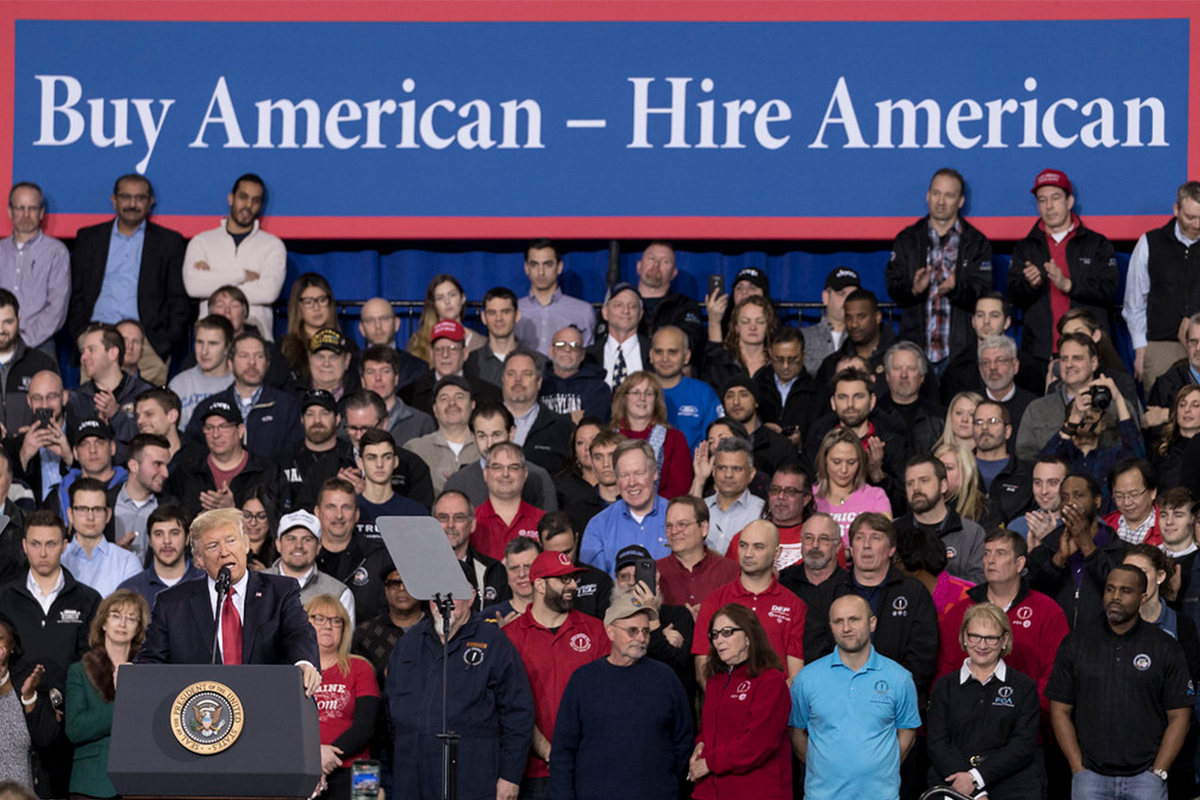
As with the other pillars of the postwar order, the existing monetary and financial system won’t necessarily implode overnight. But its erosion and deterioration will weaken the foundations of capitalism, making the whole structure more unstable.
This will be reflected in greater competition between the imperialist powers, and sharper class struggles in all countries.
The situation is analogous to the ‘multipolarity’ now seen in world relations.
Militarily, US imperialism is still by far the most powerful – and reactionary – force on the planet. But its relative decline means that it can no longer play the role of the world’s policeman: throwing its weight around in pursuit of profits, markets, and spheres of influence.
Consequently, US imperialism has been forced to make a strategic retreat in a number of places, in order to consolidate its interests in America’s ‘near abroad’. This is what Trump’s ‘America First’ approach represents in regards to foreign policy.
At the same time, America’s withdrawal has left behind a vacuum in various regions, like the Middle East and Central Africa. And other capitalist powers – like China, Russia, Turkey, and the UAE – have taken advantage of this, looking to advance their own imperialist interests.
The overall result has not been one of greater geopolitical stability, but of increased instability: more proxy wars and civil wars; more intensified competition for markets and resources; more exploitation, conflict, misery, and barbarism.
The decline of the dollar creates a similarly tumultuous scenario on the economic plane.
US capitalism is no longer able to be the linchpin of global trade and finance that it once was; no longer able to be the world’s Atlas, upholding the crumbling capitalist system.
At the same time, a ‘multipolar’ clash of the planet’s imperialist titans is no real alternative for the exploited and oppressed masses either.
The only solution is a revolutionary one, aimed at toppling this entire rotten, dilapidated edifice.
For world revolution
Whether it be the implosion of the Gold Standard in the 1930s, the collapse of Bretton Woods in the 1970s, or the decay of the dollar today: it is clear that every major, organic crisis of capitalism is reflected in a crisis of the era’s existing monetary and financial system.
In the past, however, each of these epoch-making crises begat a new economic order; a new equilibrium, based on a changed balance of forces.
Today, by contrast, the perspective is one of instability, volatility, and uncertainty; of a world turned upside down.
At the same time, previous transitions from the old order to the new involved a turbulent period of insurrectionary struggles and revolutions, in which the survival of capitalism was seriously posed by mass movements of the working class. And the same will be seen in the years ahead; in this age of austerity.
The present conundrum is a reflection of the anarchy of the capitalist market, and of the fundamental barriers to the development of the productive forces: the private ownership of the means of production, and the fetter of the nation state.
As long as the main levers of the economy sit in the hands of the bankers and bosses, and production is constrained by the straightjacket of profit, competition, and national borders, there can be no talk of harmony and order.
The way forward isn’t to roll back the wheel of history, to a time when free trade and the dollar reigned supreme, as the liberals and reformists suggest. Nor is it to embrace protectionism and economic nationalism. Both of these positions are equally reactionary.
Similarly, on a capitalist basis, demands for an internationally managed currency, or for a monetary system based on crypto or digital coins, are completely utopian.
Only through international socialist planning, on the basis of common ownership and democratic workers’ control, can the financial system be transformed into a genuine ‘public good’; into a tool that truly benefits humanity – allowing society’s economic resources to be purposefully deployed and allocated according to need, not blindly for the billionaires’ profits.
The dollar-centred global financial system was constructed over a period of 80 years. Furthermore, it was built and developed empirically, rather than consciously. Today, under capitalism, it has no alternative.
The original Bretton Woods agreement was already a motley patchwork. And this financial tangle has only become more twisted and frayed ever since.
Unravelling this complex economic tapestry, and replacing it with a new rational, stable setup is impossible within the limits of capitalism.
Instead, the workers of the world must cut through this Gordian Knot with socialist revolution.

